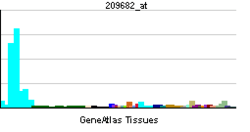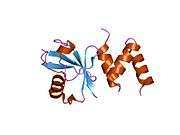CBLB (gene)
CBL-B is an E3 ubiquitin-protein ligase that in humans is encoded by the CBLB gene.[1][2] CBLB is a member of the CBL gene family.
Function
CBL-B functions as a negative regulator of T-cell activation.[3] CBL-B expression in T cells causes ligand-induced T cell receptor down-modulation, controlling the activation degree of T cells during antigen presentation.[4][5]
Clinical significance
Mutation of the CBLB gene has been associated with autoimmune conditions such as type 1 diabetes.[6][7]
Interactions
CBLB has been shown to interact with:
- CRKL,[8]
- Epidermal growth factor receptor,[9][10]
- Grb2,[8][11]
- NEDD4,[12]
- PIK3R1,[8][11] and
- SH3KBP1.[13]
References
- ↑ Keane MM, Rivero-Lezcano OM, Mitchell JA, Robbins KC, Lipkowitz S (July 1995). "Cloning and characterization of cbl-b: a SH3 binding protein with homology to the c-cbl proto-oncogene". Oncogene 10 (12): 2367–77. PMID 7784085.
- ↑ "Entrez Gene: CBLB Cas-Br-M (murine) ecotropic retroviral transforming sequence b".
- ↑ Wallner S, Gruber T, Baier G, Wolf D (2012). "Releasing the brake: targeting Cbl-b to enhance lymphocyte effector functions". Clin. Dev. Immunol. 2012: 692639. doi:10.1155/2012/692639. PMC 3328896. PMID 22550535.
- ↑ Naramura M, Jang IK, Kole H, Huang F, Haines D, Gu H (August 2002). "Pc-Cbl and Cbl-b regulate T cell responsiveness by promoting ligand-induced TCR down-modulation.". Nature Immunology 3 (12): 1192–9. PMID 12415267.
- ↑ Karwacz K, Bricogne C, MacDonald D, Arce F, Bennett CL, Collins M, Escors D (August 2011). "PD-L1 co-stimulation contributes to ligand-induced T cell receptor down-modulation on CD8+ T cells". EMBO Molecular Medicine 3 (10): 581–92. doi:10.1002/emmm.201100165. PMID 21739608.
- ↑ Hoyne GF, Flening E, Yabas M, Teh C, Altin JA, Randall K, Thien CB, Langdon WY, Goodnow CC (February 2011). "Visualizing the role of Cbl-b in control of islet-reactive CD4 T cells and susceptibility to type 1 diabetes". J. Immunol. 186 (4): 2024–32. doi:10.4049/jimmunol.1002296. PMID 21248249.
- ↑ Yokoi N, Fujiwara Y, Wang HY, Kitao M, Hayashi C, Someya T, Kanamori M, Oiso Y, Tajima N, Yamada Y, Seino Y, Ikegami H, Seino S (March 2008). "Identification and functional analysis of CBLB mutations in type 1 diabetes". Biochem. Biophys. Res. Commun. 368 (1): 37–42. doi:10.1016/j.bbrc.2008.01.032. PMID 18201552.
- 1 2 3 Elly C, Witte S, Zhang Z, Rosnet O, Lipkowitz S, Altman A, Liu YC (February 1999). "Tyrosine phosphorylation and complex formation of Cbl-b upon T cell receptor stimulation". Oncogene 18 (5): 1147–56. doi:10.1038/sj.onc.1202411. PMID 10022120.
- ↑ Schulze WX, Deng L, Mann M (2005). "Phosphotyrosine interactome of the ErbB-receptor kinase family". Mol. Syst. Biol. 1: 2005.0008. doi:10.1038/msb4100012. PMC 1681463. PMID 16729043.
- ↑ Ettenberg SA, Keane MM, Nau MM, Frankel M, Wang LM, Pierce JH, Lipkowitz S (March 1999). "cbl-b inhibits epidermal growth factor receptor signaling". Oncogene 18 (10): 1855–66. doi:10.1038/sj.onc.1202499. PMID 10086340.
- 1 2 Lavagna-Sévenier C, Marchetto S, Birnbaum D, Rosnet O (June 1998). "The CBL-related protein CBLB participates in FLT3 and interleukin-7 receptor signal transduction in pro-B cells". J. Biol. Chem. 273 (24): 14962–7. doi:10.1074/jbc.273.24.14962. PMID 9614102.
- ↑ Magnifico A, Ettenberg S, Yang C, Mariano J, Tiwari S, Fang S, Lipkowitz S, Weissman AM (October 2003). "WW domain HECT E3s target Cbl RING finger E3s for proteasomal degradation". J. Biol. Chem. 278 (44): 43169–77. doi:10.1074/jbc.M308009200. PMID 12907674.
- ↑ Szymkiewicz I, Kowanetz K, Soubeyran P, Dinarina A, Lipkowitz S, Dikic I (October 2002). "CIN85 participates in Cbl-b-mediated down-regulation of receptor tyrosine kinases". J. Biol. Chem. 277 (42): 39666–72. doi:10.1074/jbc.M205535200. PMID 12177062.
Further reading
- Fang N, Fang D, Wang HY, et al. (2002). "Regulation of immune responses by E3 ubiquitin-protein ligases". In Altman A. Signal Transduction Pathways in Autoimmunity. Current Directions in Autoimmunity 5. pp. 161–75. doi:10.1159/000060552. ISBN 3-8055-7308-1. PMID 11826757.
- Ohira M, Morohashi A, Nakamura Y; et al. (2003). "Neuroblastoma oligo-capping cDNA project: toward the understanding of the genesis and biology of neuroblastoma". Cancer Lett. 197 (1–2): 63–8. doi:10.1016/S0304-3835(03)00085-5. PMID 12880961.
- Bonaldo MF, Lennon G, Soares MB (1997). "Normalization and subtraction: two approaches to facilitate gene discovery". Genome Res. 6 (9): 791–806. doi:10.1101/gr.6.9.791. PMID 8889548.
- Bustelo XR, Crespo P, López-Barahona M; et al. (1997). "Cbl-b, a member of the Sli-1/c-Cbl protein family, inhibits Vav-mediated c-Jun N-terminal kinase activation". Oncogene 15 (21): 2511–20. doi:10.1038/sj.onc.1201430. PMID 9399639.
- Lavagna-Sévenier C, Marchetto S, Birnbaum D, Rosnet O (1998). "The CBL-related protein CBLB participates in FLT3 and interleukin-7 receptor signal transduction in pro-B cells". J. Biol. Chem. 273 (24): 14962–7. doi:10.1074/jbc.273.24.14962. PMID 9614102.
- Elly C, Witte S, Zhang Z; et al. (1999). "Tyrosine phosphorylation and complex formation of Cbl-b upon T cell receptor stimulation". Oncogene 18 (5): 1147–56. doi:10.1038/sj.onc.1202411. PMID 10022120.
- Zhang Z, Elly C, Qiu L; et al. (1999). "A direct interaction between the adaptor protein Cbl-b and the kinase zap-70 induces a positive signal in T cells". Curr. Biol. 9 (4): 203–6. doi:10.1016/S0960-9822(99)80090-6. PMID 10074432.
- Ettenberg SA, Keane MM, Nau MM; et al. (1999). "cbl-b inhibits epidermal growth factor receptor signaling". Oncogene 18 (10): 1855–66. doi:10.1038/sj.onc.1202499. PMID 10086340.
- Wong ES, Lim J, Low BC; et al. (2001). "Evidence for direct interaction between Sprouty and Cbl". J. Biol. Chem. 276 (8): 5866–75. doi:10.1074/jbc.M006945200. PMID 11053437.
- Fang D, Wang HY, Fang N; et al. (2001). "Cbl-b, a RING-type E3 ubiquitin ligase, targets phosphatidylinositol 3-kinase for ubiquitination in T cells". J. Biol. Chem. 276 (7): 4872–8. doi:10.1074/jbc.M008901200. PMID 11087752.
- Ettenberg SA, Magnifico A, Cuello M; et al. (2001). "Cbl-b-dependent coordinated degradation of the epidermal growth factor receptor signaling complex". J. Biol. Chem. 276 (29): 27677–84. doi:10.1074/jbc.M102641200. PMID 11375397.
- Arron JR, Vologodskaia M, Wong BR; et al. (2001). "A positive regulatory role for Cbl family proteins in tumor necrosis factor-related activation-induced cytokine (trance) and CD40L-mediated Akt activation". J. Biol. Chem. 276 (32): 30011–7. doi:10.1074/jbc.M100414200. PMID 11406619.
- Fang D, Liu YC (2001). "Proteolysis-independent regulation of PI3K by Cbl-b-mediated ubiquitination in T cells". Nat. Immunol. 2 (9): 870–5. doi:10.1038/ni0901-870. PMID 11526404.
- Sattler M, Pride YB, Quinnan LR; et al. (2002). "Differential expression and signaling of CBL and CBL-B in BCR/ABL transformed cells". Oncogene 21 (9): 1423–33. doi:10.1038/sj.onc.1205202. PMID 11857085.
- Yasuda T, Tezuka T, Maeda A; et al. (2002). "Cbl-b positively regulates Btk-mediated activation of phospholipase C-gamma2 in B cells". J. Exp. Med. 196 (1): 51–63. doi:10.1084/jem.20020068. PMC 2194016. PMID 12093870.
- Szymkiewicz I, Kowanetz K, Soubeyran P; et al. (2002). "CIN85 participates in Cbl-b-mediated down-regulation of receptor tyrosine kinases". J. Biol. Chem. 277 (42): 39666–72. doi:10.1074/jbc.M205535200. PMID 12177062.
- Haglund K, Shimokawa N, Szymkiewicz I, Dikic I (2002). "Cbl-directed monoubiquitination of CIN85 is involved in regulation of ligand-induced degradation of EGF receptors". Proc. Natl. Acad. Sci. U.S.A. 99 (19): 12191–6. doi:10.1073/pnas.192462299. PMC 129420. PMID 12218189.
- Strausberg RL, Feingold EA, Grouse LH; et al. (2003). "Generation and initial analysis of more than 15,000 full-length human and mouse cDNA sequences". Proc. Natl. Acad. Sci. U.S.A. 99 (26): 16899–903. doi:10.1073/pnas.242603899. PMC 139241. PMID 12477932.
| |||||||||||
This article is issued from Wikipedia - version of the Sunday, December 20, 2015. The text is available under the Creative Commons Attribution/Share Alike but additional terms may apply for the media files.



